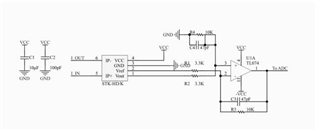Hi,
Can the ADC on MSPM0 measure current with the circuit below?

The positive input of the OPAMP is 2.5 V, and the negative input is from 0 to 5 V.
The ASCVRSEL will be set to 0 or 2. (0h = VDDA reference. 2h = Internal reference.)
We can't use the EXTREF pin.
The current ranges from 0A to 80A.
Is there an app note or circuit related to the current measurement using M0?
Thanks.

